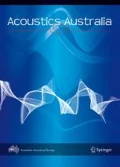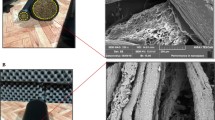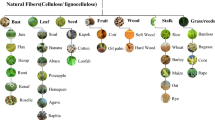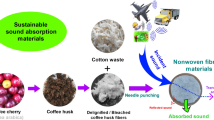Abstract
The remarkable properties of natural lignocellulosic fibers such as biodegradability, light weight, low density, low cost and non-toxicity as well as being an alternative to sound absorbers made of synthetic fibers have attracted many researchers in the field of acoustics. The purpose of the present study was to compare the estimated sound absorption coefficient of composite samples made of natural coconut fibers by using empirical models and comparing them with the results of experimental data. The normal sound absorption coefficients of the samples were measured with an impedance tube. The samples were fabricated in three different thicknesses (25, 35 and 45 mm) with air gaps behind them and had a constant density of 200 kg/m3. Next, calculations were made to estimate the absorption coefficients of the samples by coding in MATLAB and using the differential equation algorithm along with Delany–Bazley, Miki and Johnson–Champoux–Allard models. Based on the results, the sound absorption coefficients of the samples increased significantly with increasing frequency. Additionally, increasing the thickness of materials at constant densities increases the absorption of sound, especially at lower frequencies (< 1000 Hz). Comparison of the experimental data and estimations of the models showed that by increasing thickness, the predicted acoustic absorption coefficients for the samples become closer to the data from the experimental tests. At frequencies < 1000 Hz, increasing the air gap at the back of the sample to 3 cm would elevate the values of sound absorption coefficient. The samples made of coir fibers would effectively dissipate the energy of sound waves. It is noted that increasing the absorption of the sound in such materials is related to the longer depreciation process of thermal and viscous transfer between the air and the absorbing materials in the composite.









Similar content being viewed by others
References
Amares, S., et al.: A review: characteristics of noise absorption material. In: Journal of Physics: Conference Series. IOP Publishing (2017)
Berardi, U., Iannace, G.: Acoustic characterization of natural fibers for sound absorption applications. Build. Environ. 94, 840–852 (2015)
Tang, X., Yan, X.: Acoustic energy absorption properties of fibrous materials: a review. Compos. A Appl. Sci. Manuf. 101, 360–380 (2017)
Arenas, J.P., Crocker, M.J.: Recent trends in porous sound-absorbing materials. Sound Vib. 44(7), 12–18 (2010)
Elwaleed, A., et al.: Experimental investigation of sound absorption properties of perforated date palm fibers panel. In: IOP Conference Series: Materials Science and Engineering. IOP Publishing (2013)
Iannace, G., Maffei, L., Trematerra, P.: On the use of “green materials” for the acoustic correction of classrooms. In: Proceedings of the EURONOISE (2012)
Yang, W., Li, Y.: Sound absorption performance of natural fibers and their composites. Sci. China Technol. Sci. 55(8), 2278–2283 (2012)
Mamtaz, H., et al., Acoustic absorption of natural fiber composites. J. Eng. 2016, 1–11 (2016)
Bribián, I.Z., Capilla, A.V., Usón, A.A.: Life cycle assessment of building materials: comparative analysis of energy and environmental impacts and evaluation of the eco-efficiency improvement potential. Build. Environ. 46(5), 1133–1140 (2011)
Berardi, U., Iannace, G.: Predicting the sound absorption of natural materials: best-fit inverse laws for the acoustic impedance and the propagation constant. Appl. Acoust. 115, 131–138 (2017)
Ayub, M., et al.: Analysis on sound absorption of natural coir fiber using Delany–Bazley model. In: Proceedings of the 8th International Conference on Mechanical Engineering (ICME2009) (2009)
Asdrubali, F., D’Alessandro, F., Schiavoni, S.: A review of unconventional sustainable building insulation materials. Sustain. Mater. Technol. 4, 1–17 (2015)
Patnaik, A., et al.: Thermal and sound insulation materials from waste wool and recycled polyester fibers and their biodegradation studies. Energy Build. 92, 161–169 (2015)
Aksogan, O., Resatoglu, R., Binici, H.: An environment friendly new insulation material involving waste newsprint papers reinforced by cane stalks. J. Build. Eng. 15, 33–40 (2018)
Secchi, S., et al.: Experimental and environmental analysis of new sound-absorbing and insulating elements in recycled cardboard. J. Build. Eng. 5, 1–12 (2016)
Jayamani, E., Bakri, M.K.B.: Lignocellulosic fibres reinforced polymer composites for acoustical applications. In: Kalia, S. (ed.) Lignocellulosic Composite Materials, pp. 415–444. Springer, Berlin (2018)
Jayamani, E., et al.: Acoustic and thermal properties of polymer composites reinforced with lignocellulosic fibers. In: Applied Mechanics and Materials. Trans Tech Publ (2014)
Verma, D., et al.: Coir fibre reinforcement and application in polymer composites: A. Environ. Sci. 4(2), 263–276 (2013)
Bettini, S., et al.: Investigation on the use of coir fiber as alternative reinforcement in polypropylene. J. Appl. Polym. Sci. 118(5), 2841–2848 (2010)
Berardi, U., Iannace, G., Di Gabriele, M.: The acoustic characterization of broom fibers. J. Nat. Fibers 14(6), 858–863 (2017)
Fouladi, M.H., Ayub, M., Nor, M.J.M.: Analysis of coir fiber acoustical characteristics. Appl. Acoust. 72(1), 35–42 (2011)
Bansod, P.V., Mittal, T., Mohanty, A.R.: Study on the acoustical properties of natural jute material by theoretical and experimental methods for building acoustics applications. Acoust. Aust. 44(3), 457–472 (2016)
Delany, M., Bazley, E.: Acoustical properties of fibrous absorbent materials. Appl. Acoust. 3(2), 105–116 (1970)
Stelte, W., et al.: Coir fibers as valuable raw material for biofuel pellet production. Waste Biomass Valoriz. (2018). https://doi.org/10.1007/s12649-018-0362-2
Harish, S., et al.: Mechanical property evaluation of natural fiber coir composite. Mater. Charact. 60(1), 44–49 (2009)
Islam, M.N., et al.: Physico-mechanical properties of chemically treated coir reinforced polypropylene composites. Compos. A Appl. Sci. Manuf. 41(2), 192–198 (2010)
Limpan, N., et al.: Properties of biodegradable blend films based on fish myofibrillar protein and polyvinyl alcohol as influenced by blend composition and pH level. J. Food Eng. 100(1), 85–92 (2010)
Egab, L., Wang, X., Fard, M.: Acoustical characterisation of porous sound absorbing materials: a review. Int. J. Veh. Noise Vib. 10(1–2), 129–149 (2014)
Allard, J., Atalla, N.: Propagation of Sound in Porous Media: Modelling Sound Absorbing Materials 2e. Wiley, New York (2009)
Maderuelo-Sanz, R., et al.: Acoustical performance of porous absorber made from recycled rubber and polyurethane resin. Latin Am. J. Solids Struct. 10(3), 585–600 (2013)
Olny, X., Panneton, R.: Acoustical determination of the parameters governing thermal dissipation in porous media. J. Acoust. Soc. Am. 123(2), 814–824 (2008)
Champoux, Y., Allard, J.F.: Dynamic tortuosity and bulk modulus in air-saturated porous media. J. Appl. Phys. 70(4), 1975–1979 (1991)
Standard, B.: Acoustics-determination of sound absorption coefficient and impedance in impedance tubes—part 2: transfer-function method. BS EN ISO, p. 10534-2 (2001)
Miki, Y.: Acoustical properties of porous materials—modifications of Delany–Bazley models. J. Acoust. Soc. Jpn. E 11(1), 19–24 (1990)
Allard, J.F., Champoux, Y.: New empirical equations for sound propagation in rigid frame fibrous materials. J. Acoust. Soc. Am. 91(6), 3346–3353 (1992)
Nor, M.J.M., et al.: Effect of different factors on the acoustic absorption of coir fiber. J. Appl. Sci. 10(22), 2887–2892 (2010)
Oliva, D., Hongisto, V.: Sound absorption of porous materials—accuracy of prediction methods. Appl. Acoust. 74(12), 1473–1479 (2013)
Crocker, M.J.: Handbook of Noise and Vibration Control. Wiley, New York (2007)
Author information
Authors and Affiliations
Corresponding author
Additional information
Publisher’s Note
Springer Nature remains neutral with regard to jurisdictional claims in published maps and institutional affiliations.
Rights and permissions
About this article
Cite this article
Taban, E., Tajpoor, A., Faridan, M. et al. Acoustic Absorption Characterization and Prediction of Natural Coir Fibers. Acoust Aust 47, 67–77 (2019). https://doi.org/10.1007/s40857-019-00151-8
Received:
Accepted:
Published:
Issue Date:
DOI: https://doi.org/10.1007/s40857-019-00151-8




